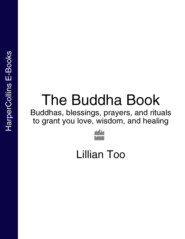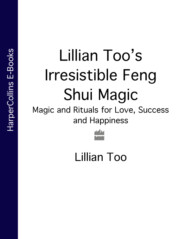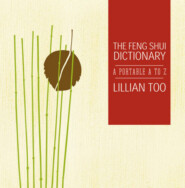По всем вопросам обращайтесь на: info@litportal.ru
(©) 2003-2024.
✖
Lillian Too’s Smart Feng Shui For The Home: 188 brilliant ways to work with what you’ve got
Автор
Год написания книги
2019
Настройки чтения
Размер шрифта
Высота строк
Поля
The south (trigram Li): Eyes
The northwest (trigram Ch’ien): Head
22 – the eight substances indicated by the trigrams
There is a close relationship between different feng shui formulae and the trigrams of the Pa Kua. Knowing the eight substances associated with each trigram fosters valuable insights into them.
The eight substances and their trigram origins and compass directions are summarized here.
Fire links to the trigram Li in the south. This substance is also one of the Five Elements. This trigram symbolizes the brightness of fire and the dazzle of the sun. It stands for glory; the applause of the masses. Li also suggests activity and heat. The symbolism of the Fire substance is that of a great man who perpetuates the light by rising to prominence. The color of Li is red, the bright red that suggests celebrations and happy occasions. To benefit from the chi of the south, activate Fire in this corner.
Heaven is associated with leadership, massive yang forces, and power. The trigram is Ch’ien and the direction is northwest, the place of the patriarch. To attract the luck of heaven, activate with gold energy simulated by metal objects. To produce good feng shui for the father, place a pile of polished decorative stones in the northwest corner. Spray gold paint on the stones to simulate gold. This is a good technique, as the Element of the northwest is Big Metal, and in feng shui terms, metal is like gold. The pile of stones represents the Earth Element in which gold is found. The energies created are in harmonious balance.
Earth and Mountain These down-to-earth, grounding substances are represented by the powerful K’un and Ken trigrams. These substances of the Earth Element stand for matriarchal wisdom forces that signifies real strength, sustenance, and family-related happiness. A pile of boulders here is excellent, but do not exhaust the Earth energy by spraying gold. A crystal cluster is also excellent. The directions are southwest and northeast.
Water is the substance of power and wealth. It is a substance that can bring great prosperity or hardship and suffering, so the water chi must be harnessed carefully. It has a double-edged effect: placed in the north, water brings luck, but differentiate between the flow of water and actual placement of water. It is easier to work with water features than to harness luck from water flow, so a fish tank in the north corner of the living room, for example, is always good and always beneficial.
The other three substances are symbolized by the lake, thunder, and wind. These align with the trigrams in the west, east, and southeast. Paintings and decorative objects give life to the energies of these substances.
Gold stones in the northwest create patriarch luck.
Fish in the north of the living room bring wealth luck.
23 – the yin and yang of the four cardinal directions
In feng shui practice, it is helpful to develop sensitivity to yin and yang energies. This understanding means the difference between success and failure when placing all your feng shui enhancers.
In a similar way to placing the final piece in the feng shui jigsaw, yin and yang energy makes the picture whole and complete. So understanding its manifestations is a crucial starting point in developing feng shui instincts.
The Chinese believe that yin and yang forces give existence to each other. So, yin is passive, darkness, night, cold, quiet, and stillness; yang, on the other hand, is positive, daylight, brightness, warmth, heat, sounds, and activity. They cannot exist without the other, so without the yin of cold there is no yang warmth, and without yang sunshine, there can be no yin moonlight! Another attribute of the yin-yang cosmology is that one contains the seed of the other. So in yang there must always be a little bit of yin, and vice versa, so that when there is an excess of either, the space affected is said to be unbalanced and not in harmony. When such a situation occurs, it is felt that there just cannot be any good luck.
So in feng shui, yin-yang balance requires the simultaneous presence of both the forces. However, because we are dealing with life energy when we speak of yang feng shui, it is vital that the environment must always have yang energy and yet should never be too yin. Maintaining this very delicate balance between the two forces is really the essence of feng shui practice – what it is essentially all about.
Yin and yang for male and female
The yin and yang aspects of directions are usually indicated by the + and – signs; plus and minus, positive and negative. So every one of the eight directions contains both yin and yang aspects. In the cardinal directions north, south, east, and west, there is more yin than yang, but this signifies strong yang and weak yin. Indeed, this situation indicates a young, emerging, and vibrant yang. The distribution of yin and yang forces for all the four cardinal directions is therefore yang, yin yin or plus minus minus in the first, second, and third sub-directions of each sector.
So, for example, in the north there is north 1, north 2, and north 3; north 1 is yang, and north 2 and 3 are yin. So males should always choose north 2 and north 3 as their most suitable north directions, while females should always select north 1 as their auspicious northerly direction. When you do this, you will find that it helps to cement the yin and yang presence, which then strengthens the balance that brings you success in your life and good fortune.
Always take note of this particular fine point when working with your directions and the corners of you home as, by using this method, you will find this is the optimum way of ensuring that your feng shui will work for you.
A Chinese Luo Pan compass with the yin and yang allocations for the four cardinal directions and the four sub-directions.
24 – the yin and yang of the secondary four directions
The secondary directions of the compass also contain both yin and yang aspects. As for the four cardinal directions, it is very important to study their attributes.
In the secondary directions, the yin and yang aspects are also signified by the + and – signs.
Once again, there are plus and minus sub-directions as well as positive and negative connotations to the directions. But here in the northeast, southeast, northwest, and southwest (see the compass here (#ulink_2e9ee9ab-55da-5525-bcc8-68e4a02da898)) there is more yang than yin energy. This situation signifies a strong yin and weak yang. It indicates a young, emerging, and vibrant yin, while yang has grown old and is now tired. The distribution of yin and yang forces for all four secondary directions is therefore yin-yang-yang, or minus-plus-plus in the first, second, and third sub-directions of each sector. So, for example, in the southwest sector, there is southwest 1, southwest 2, and southwest 3. Southwest 1 is yin and southwest 2 and 3 are yang. So males should choose southwest 1 as their most suitable southwest directions, while females should select southwest 2 or 3 as their auspicious southwest direction.
This seals the yin and yang presence, which will, in turn, strengthen the balance that brings you good feng shui. Do not forget to take note of this particular fine point when you are working with your directions and the corners of you home, and especially when you are practicing the personalized directions of Eight Mansions feng shui (see Chapter 4 (#litres_trial_promo).)
This is truly an important fine point that ensures success for you in your feng shui work. Shown here (#ulink_2e9ee9ab-55da-5525-bcc8-68e4a02da898) is an illustration of the compass directions with the sub-directions marked in and also the yin and yang subdirections clearly depicted. These sub-directions are referred to by advanced feng shui practitioners as the 24 mountains, which themselves contain further keys to the unlocking of advanced feng shui formulas. Now you know that this term merely refers to the three subsections of the eight compass directions.
2 feng shui makeovers for interiors (#ulink_27b3ebcc-44e7-50d1-9704-116a40948fa0)
25 – regularize the shape of your floor plan
The shape and structure of every piece of furniture and decorative item inside the living space of any home has either good or bad feng shui implications.
The basic principles concerning auspicious or inauspicious shapes are based on: whether the shapes are regular or irregular, whether there are missing or protruding corners, the Element attribute of the shape itself, and whether the shape resembles a lucky or hostile symbol.
Auspicious shapes
These are a perfect square or rectangular, whether flat to show the layout of rooms, or standing to represent the vertical shape of buildings or furniture. These are the most regular shapes, and are the easiest to work with to produce good feng shui.
Inauspicious or difficult shapes
These are believed to create imbalances and an uncertain flow of chi. Layouts where the room is an odd shape often cause the luck of the occupants to be uncertain and unstable. To improve fortunes, such shapes should be regularized with clever placement of furniture, and using floor and wall colors and lighting to create different perspectives. Always strive to regularize the appearance of any room with its interior decoration as it will always make it more auspicious.
Irregular shapes
These give rise to missing corners and will always create problems in interior feng shui. The severity of the problem depends on which corner is missing. So if you divide your home layout into nine equal grids (see here (#u2063e199-52de-4a99-abbb-fc9b103f6f1b)) and then check the compass direction of each of the grids you will be able to identify the compass direction represented by the missing corner.
Auspicious shapes
Inauspicious shapes
26 – auspicious shapes for home interiors
When I refer to shapes, I mean the shape of the layout of the entire house as well as the shape of individual rooms and the walls inside each room.
It is always preferable to opt for a regular symmetrical shape. In feng shui terms anything that is irregular or asymmetrical always indicates that something is missing or is incomplete. So a full square is always a better shape than a narrow version of one. A full circle is always better than a half circle, and for this reason bay windows are seldom encouraged as good feng shui. Small irregularities in the corners of rooms are equally discouraged. The Pa Kua (or eight-sided shape), the diagnostic tool used in feng shui, is also considered a very auspicious shape especially when it is used for dining and coffee tables.
The Pa Kua-shaped dining table is superb for a family with three generations living together. You can allocate the chairs according to each person’s best directions.
Square-shaped dining tables are excellent for a small family. The shape suggests perfect balance and grounded symmetry creating easy, harmonious relationships.
Colour and shape
Walls should always be painted to make the regularity of their shape stand out.
Here are some guidelines for using shape and color to bring family harmony and success. Rectangular walls which are taller rather than broader (without appearing incomplete) are particularly good in the east and southeast corners as this shape signifies growth and success. This is the shape of the Wood Element and Wood suggests the season of spring, a time of growth.
Perfectly square shapes, which belong to the Earth Element, are ideal for the dining room and the dining table since not only does this reflect the stability of grounding energy, but Earth also stands for the mother. The energy of the square shape is very balanced and is very auspicious for family harmony.
Round shapes denote the Metal Element and these are suitable for the west and northwest areas. It is a good idea to create a perfect round patch with clever paintwork techniques on any northwest wall so that you create auspicious luck for the patriarch of the family. Paint it gold for added radiance and additional good luck symbolism. Do not make the shape too large as the round shape can be overpowering for residential homes. In large corporate offices, however, they are ideal when featured in the northwest.










